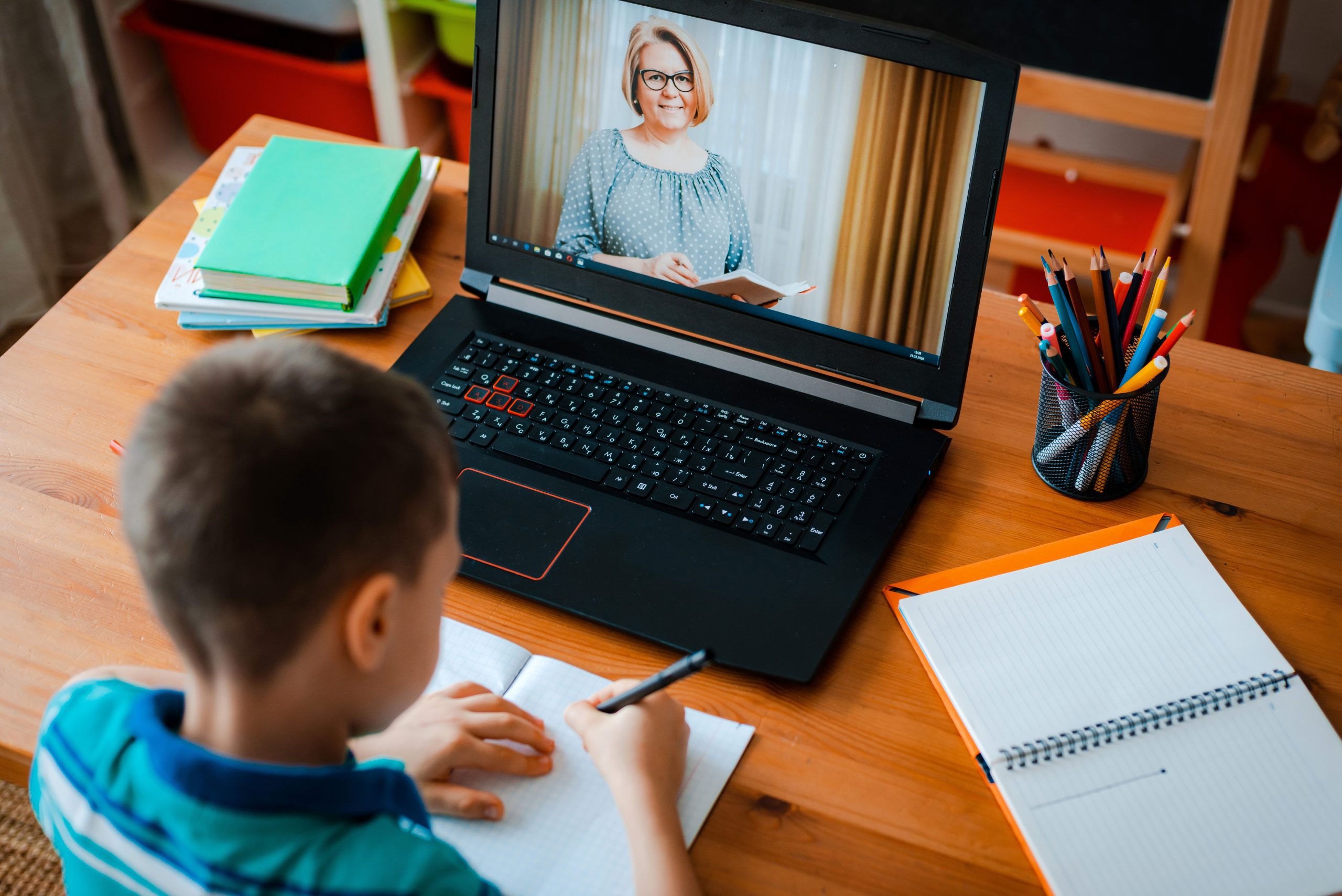The Dystopian Hellscape of Online Learning

In Look to Windward, a science fiction novel from the late Scottish author Iain M. Banks, perfectly clear video and audio can be instantaneously transmitted across vast interstellar distances, yet people still vie to be physically present at a concert. This is something to consider the next time your local school board assures you that the classroom experience can be recreated on Zoom.
Last spring, the early stages of the Covid-19 pandemic forced schools across the country to adopt “online learning,” a euphemism for teachers yelling impotently at the disembodied heads of 20 students on a flickering video screen. The reasons for this were understandable. One sympathizes with educators and administrators forced to resort to untried digital platforms in the midst of an unprecedented public health crisis.
However, good intentions and heroic improvisatory efforts should not blind us to the shortcomings of online learning, shortcomings that are unlikely to be addressed by newer apps, better video quality, or more expensive tablets. The Covid-19 pandemic has laid bare a fundamental truth about education: There is no replacement for the physical presence of an engaged teacher in the classroom.
The mechanics of online learning unintentionally bring to mind the atmosphere of the late 20th century Eastern Bloc. Teachers have become digital overseers, attempting to gauge student interest through constant monitoring of grainy video footage. On screen, they appear as distant figures barking orders at cowering underlings. As in the crumbling Soviet regimes of the 1980s, this surveillance is ubiquitous but often ineffectual. Like sullen party members dutifully mouthing empty slogans, students have learned to feign interest while surfing the internet or chatting with friends. The resulting arrangement prizes superficial attentiveness above all else.
Laggy video and imperfect technology also impose certain immutable constraints on classroom instruction. During the spring lockdown, a teacher friend admitted that he would simply mute his rambunctious students en masse while lecturing, thus completely removing verbal feedback from the lesson. Many other teachers resorted to busywork assignments to convince parents and superiors that they were still getting things done. In a sadly ironic twist, technology has brought back the worst features of an older lecture-and-homework-oriented approach to education.
Many have remarked on the consequences of remote learning for poorer students, who often lack the requisite technology or familial support to succeed in the digital classroom. Another likely outcome is a widening of the academic gender gap. Boys, who are generally less detail-oriented and more hyperactive than their female classmates, often struggle with time-management, homework, and the banal organizational demands of schooling. The persistent gender gap in high school homework time is startling evidence of these deficiencies. The replacement of classroom activities with digital box-checking—download these four apps to optimize your online experience, give this comment a thumbs up to signify you’ve read and understood the assignment, submit your worksheet via Microsoft Teams or it won’t count—has only exacerbated these problems. A likely outcome of forcing schools online is a lost year for many boys and young men.
Educational entrepreneurs, attuned to Americans’ enthusiasm for novel technological gimcracks, assure us that apps, tablets, and games will improve student outcomes. Even if we could solve the practical problems posed by online learning, the overuse of classroom technology mires schools in an arms race they are almost certain to lose. No learning app can compete with games or social media platforms purpose-built to ensnare users for hours at a time. And what is the underlying message of digitizing and gamifying the classroom? That school is merely a pale imitation of the electronic diversions students really crave.
The shift to online learning was an understandable recourse last spring, when the pandemic and its means of transmission were barely understood and many feared an Italy-style tidal wave of hospitalizations. This fall, despite ample time to prepare and a greater understanding of the virus, remote instruction is still astonishingly prevalent. According to Education Week, nearly half of American school districts restarted remotely, including 74 percent of the 100 largest districts in the country. A further 27 percent of all school districts are pursuing a hybrid strategy that combines remote learning with in-person instruction. Less than a quarter of all school districts reopened fully.
As another wave of the virus crests, schools are again retreating to online instruction or finding new excuses not to return to the classroom. Despite a remarkably low rate of student transmission, New York City public schools closed in late November thanks to a deal struck between Mayor Bill de Blasio and the teachers’ unions. While California Governor Gavin Newsom’s children continue to attend classes at a private Sacramento school, most California public schools remain closed. Over the summer, many blamed teachers’ reluctance to return to schools on President Trump’s rhetorical bluster and managerial deficiencies. Now, even an incoming Biden administration and blue state governors can’t coax teachers’ unions to give ground on in-person instruction.
Whatever the reason for teachers’ reluctance to return to school, we’ve missed an opportunity: The young are not only remarkably resistant to the virus, they also seem unlikely to transmit it to vulnerable parents, teachers, and friends. Instead of taking advantage of this stroke of epidemiological good luck, too many school districts have opted for an overly cautious approach. Meanwhile, the costs of online schooling have begun to mount.
A California seventh grader has been threatened with arrest for failing to report for online classes. In Washington, D.C., K-2 grades have reported a nine percent drop in students meeting literacy benchmarks, while D.C. kindergartens have experienced an astonishing 22 percent drop. In St. Paul, Minnesota, 40 percent of all high school grades assigned remotely are failing grades. Across the country, students are bearing the brunt of an overly cautious approach to the pandemic.
From the military to the classroom, throwing money and technology at a problem is a characteristically American approach. However, our fixation on digital life seems to have foreclosed creative analog solutions for schooling in the Covid-19 era. Tech entrepreneur Peter Thiel has argued that over the past few decades, Silicon Valley’s outsized cultural and financial footprint has sucked up capital, ideas, and talent that could have revitalized other industries. A similar critique could be leveled at the educational establishment’s approach to the pandemic. A society-wide obsession with digital novelty has blinded us to alternative solutions.
 Why not hold classes outdoors in parks and other public spaces? Why not adjust the school calendar to take advantage of pleasant weather while avoiding the crowded winter months? Why not, as Zeynep Tukfekci writes in The Atlantic, have the National Guard build open-air tent cities to replace stuffy, poorly ventilated classrooms? Why not, at a time of mass unemployment, hire young, healthy proctors to supervise classes in person with lesson plans prepared by older, at-risk teachers? Instead of liberating us to think differently, technology has narrowed the scope of our imaginative capacities. There now is only one field for innovation, and it is always digital.
Why not hold classes outdoors in parks and other public spaces? Why not adjust the school calendar to take advantage of pleasant weather while avoiding the crowded winter months? Why not, as Zeynep Tukfekci writes in The Atlantic, have the National Guard build open-air tent cities to replace stuffy, poorly ventilated classrooms? Why not, at a time of mass unemployment, hire young, healthy proctors to supervise classes in person with lesson plans prepared by older, at-risk teachers? Instead of liberating us to think differently, technology has narrowed the scope of our imaginative capacities. There now is only one field for innovation, and it is always digital.
It may be too late to radically shift our approach to teaching in the Covid-19 era, but we can at least take this opportunity to reconsider the relationship between technology and schooling. Too often, innovation is hailed as an educational cure-all, probably because it promises an easy way around sticky problems like school quality, socio-economic disparities among families and neighborhoods, and innate differences in student ability. But the lockdowns have demonstrated that technology untethered from the traditional classroom is, at best, a stopgap measure. It can supplement old-fashioned teaching, but it will never replace it.
Over the past decade, the utopian promise of new technology has given way to the harsh reality of digital life. From dating apps to social media to fake news, the unsatisfying and even harmful consequences of online culture are widely acknowledged but rarely confronted. If the internet can’t deliver on its promise of connectivity and community in the realm of interpersonal relationships, why would education be any different? When we finally return to the classroom, teachers and students alike should get back to pencils, papers, and notebooks.
Will Collins is a teacher in Budapest, Hungary.